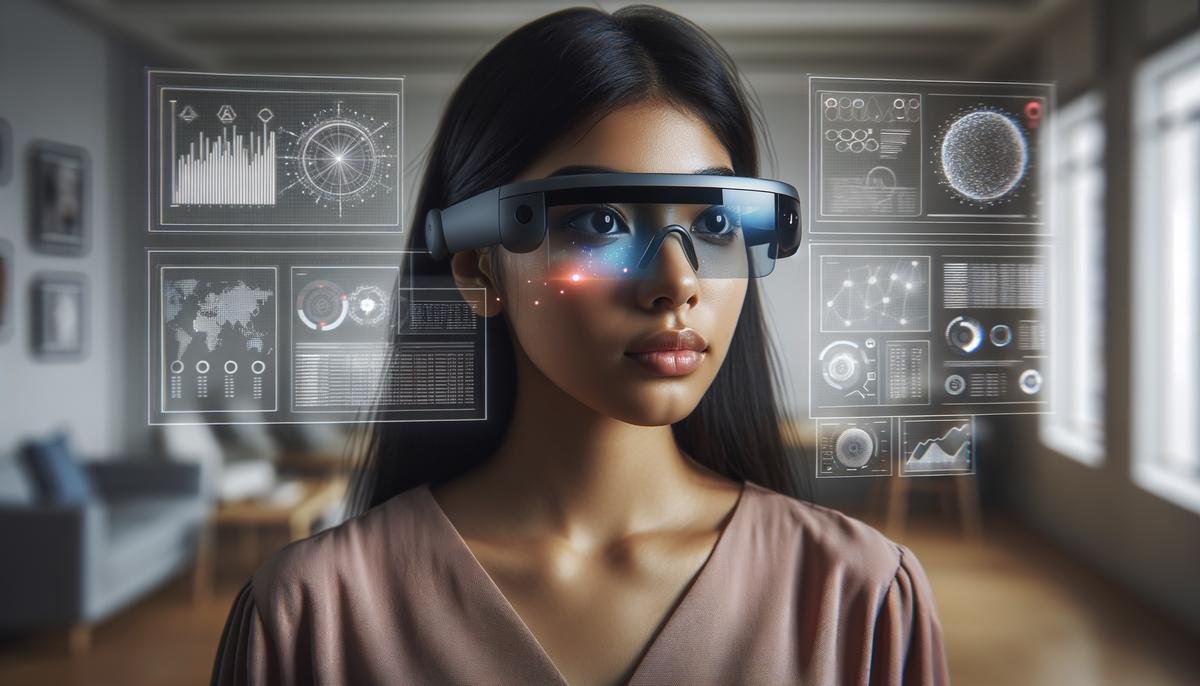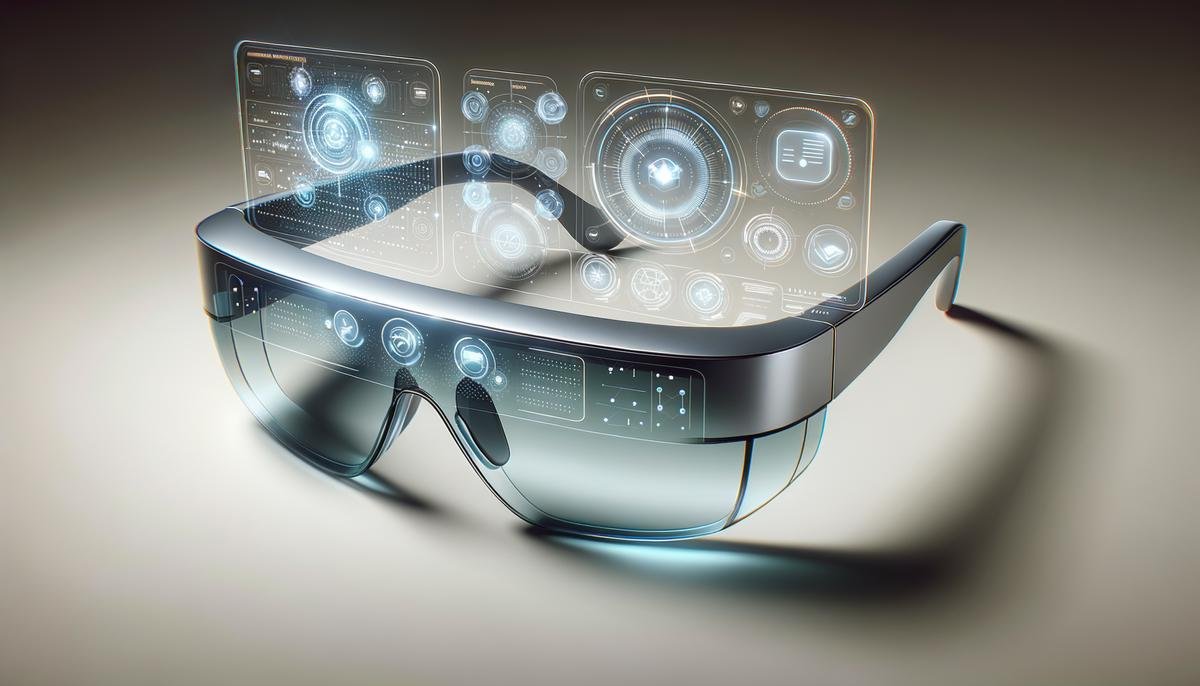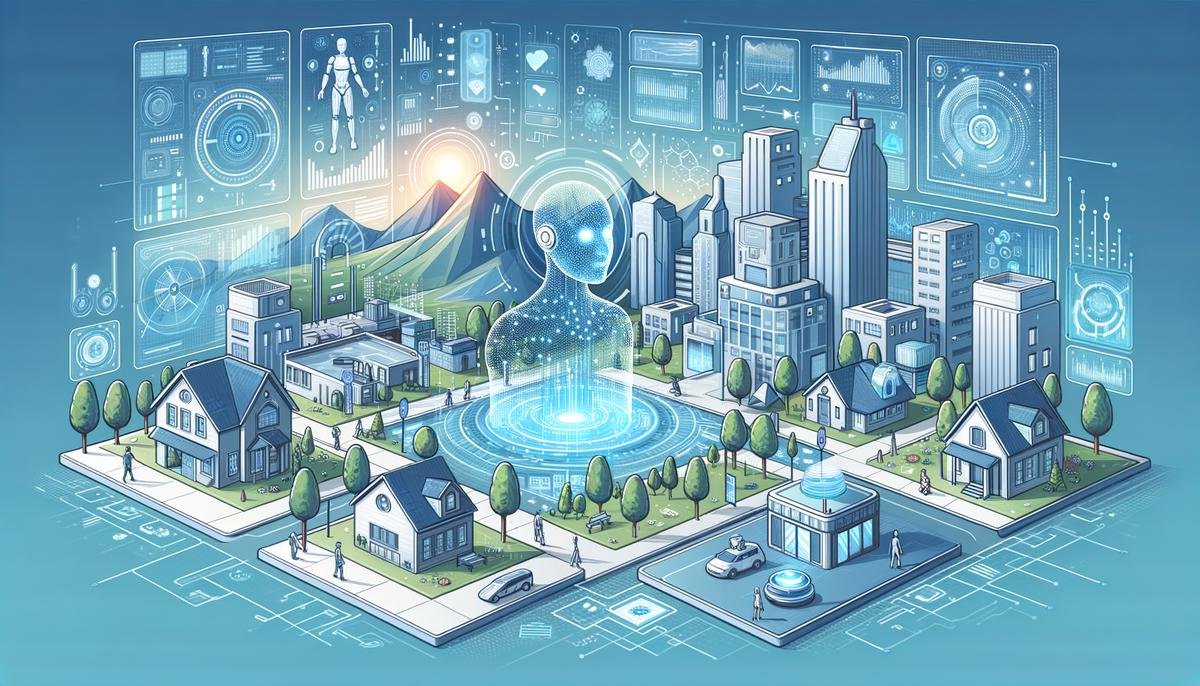Augmented reality and artificial intelligence might sound like something out of a sci-fi novel, but they’ve been creeping into our day-to-day lives for a while now. As if by magic, AR allows us to see the world in a new light, all with a little help from AI. The journey from the first time someone overlaid digital data onto a real-world view to the hyper-smart, AI-infused AR we have today is nothing short of remarkable. Far from simply being cool tech, these advancements have been game-changing, offering new ways to play, learn, and connect with the world around us. Strap in as we explore the ins and outs of AR’s evolution and the integration of AI that’s making it all the more mind-blowing.
Evolution of Augmented Reality and AI Integration
The Fusion of AI and Augmented Reality: Leveling Up Our World
When you hear “augmented reality” (AR), think of a digital world laid over our own, like Pokémon appearing in a city park on your phone. Now, mix in artificial intelligence (AI), the smart tech that can learn and make decisions, and the game changes. AR no longer just slaps a digital image on what you see. It reacts, understands, and personalizes the experience, all thanks to AI’s brainpower.
This blend of AI and AR is already shaping how we interact with the world around us. From shopping and gaming to education and healthcare, it feels like stepping into the future. Let’s lean in close and unpack just how AI is reinventing AR experiences.
We begin with our smartphones, acting as magic windows to these AI-enhanced AR worlds. Picture this: you’re furniture shopping and see a couch that might look good in your living room. With an AR app, powered by AI, you can see that couch in your space, in real-time, through your phone’s camera. And it doesn’t stop there. AI digs into what it knows about your preferences to suggest color options you’re likely to love. AI makes AR smart, not just visually impressive.
Education’s getting an overhaul, too, turning classes into interactive, immersive experiences. Remember struggling to grasp complex science concepts from dusty textbooks? No more. AR layers 3D models over real-world labs, and with AI in the mix, these models can guide students through experiments, adjusting to each learner’s pace. It’s like having a personal tutor in your pocket, making learning click by literally showing you the way.
And when it comes to fun and games, AI-driven AR creates adventures tailormade for you. Video games leap out of the screen and into your living room. The AI in the game assesses your space, dodging that coffee table and making sure the action fits perfectly in your room. Plus, as the AI learns how you play, the challenges bend and twist to stay exciting, keeping you on your toes.
In the healthcare sphere, AR glasses have stepped up to the plate. Surgeons put on these high-tech specs, and voila, crucial data pops up right in their field of vision. AI sorts through heaps of medical info in real-time, giving doctors just what they need to know, hands-free, while they operate.
This AI-AR fusion is also a power play for accessibility. Imagine someone who can’t read signs or labels in a store. AI-assisted AR glasses can read text out loud for them or even translate different languages on the fly. It’s like wearing a personal assistant on your face, one that understands the world and your needs.
But this tech isn’t just coasting; it’s getting better every day. AI keeps learning and expanding what AR can do. Each interaction, swipe, and tap feeds the system, making it smarter and more dialed into crafting those wow moments.
The partnership between AI and AR is turning the stuff of science fiction into everyday reality, and it’s just getting started. Imagine machines that can think ahead about what you might like to see or do, combined with AR that can project your deepest digital dreams onto the world around you. That’s where we’re headed – a future where our digital and physical lives intertwine, powered by the ever-growing synergy of AI and AR.

Current Technologies and Innovations in AR/AI
Pushing the boundaries in the seamless marriage of augmented reality (AR) and artificial intelligence (AI), developers and engineers are exploring uncharted territories, crafting experiences that once resided in the realms of science fiction.
As these technologies intertwine, it’s not merely about overlaying digital content onto the real world—it’s about creating intelligent, context-aware systems that understand and anticipate user needs.
One cutting-edge innovation lies in the realm of AR smart glasses optimized through AI, which are no longer clumsy prototypes but sleek, user-friendly devices.
These glasses leverage advanced AI to analyze the user’s environment, recognize objects and faces, and present relevant information right before their eyes—turning the environment into an interactive knowledge base.
Moreover, real-time language translation is an area where AR and AI are making giant strides.
Imagine a world where language barriers dissolve as AI-powered AR devices translate foreign text on signs, menus, or documents in real-time.
This could revolutionize global communication, tourism, and business operations, fostering a more interconnected world.
Another innovation is the advent of AI-driven gesture control in AR environments.
Through sophisticated machine learning algorithms, AR devices can now interpret and respond to a user’s hand movements with startling accuracy.
This intuitive interaction paves the way for more naturalistic and engaging AR experiences that move beyond the confines of traditional input devices.
In the high-stakes domain of autonomous vehicles, AR and AI advancements are converging to heighten safety features.
AR heads-up displays (HUDs) provide drivers with crucial, real-time information designed to heighten situational awareness without causing distraction.
Coupled with AI’s ability to process vast streams of sensor data, this tech assists in making split-second decisions that could be lifesaving.
Spatial computing also leaps forward as AR and AI integration evolves.
Using AI to understand and manipulate spatial data allows AR systems to embed digital objects within physical spaces with impressive precision.
This means that virtual furniture can cast real shadows, digital art can hang on actual walls, and virtual assistants can guide users through complex tasks with spatial relevance in real-time environments.
Lastly, facial recognition technology has made significant advancements through the synergy of AR and AI.
Beyond security applications, this technology tailors personal experiences, such as trying on virtual makeup or accessories, with a remarkable level of realism.
AI algorithms work relentlessly to process facial data points, making sure that interactions are smooth, realistic, and most importantly, secure.
As the digital landscape continues to expand, the combination of AR and AI stands as a cornerstone of innovation.
These advancements not only transform the way we interact with technology but also redefine what it means to be connected—to information, environments, and one another.
With an eye fixed firmly on the horizon, the fusion of AR and AI is forging a new era where the limits of what’s possible are ever-expanding, ushering in experiences that truly break the mold of traditional technology interaction.

Challenges and Ethical Considerations
As the merger of augmented reality (AR) and artificial intelligence (AI) continues to reshape the way we interact with technology, it brings to the fore a host of challenges and ethical dilemmas. These emerging technologies, while holding immense potential, also conjure concerns that necessitate careful consideration.
Privacy issues sit at the heart of this technological convergence. AR devices, equipped with AI, have the capability to collect, analyze, and store vast amounts of personal data. As these devices perceive the environment, they might inadvertently capture sensitive information about individuals who have not consented to such surveillance. This data could include biometric data, daily routines, or even private conversations. Securing this information is paramount, as any breach could lead to significant invasions of privacy.
Bias and misinformation are additional concerns. AI systems are only as good as the data they are trained on. If this data has inherent biases – which it often does – the AI will propagate these biases in its functioning. In an AR context, this could lead to discriminatory practices, such as AR filters that favor certain skin tones or facial structures. There’s also the possibility for AI-driven AR content to manipulate reality, blurring lines between what’s real and what’s computer-generated, thus raising alarms about the spread of misinformation.
Accountability is another tricky area in the AI-integrated AR landscape. When an AI-driven AR system makes a decision, it can be challenging to trace the logic behind that decision due to the complexity of machine learning algorithms. This issue of algorithmic accountability becomes even more pressing when these decisions impact critical areas of life, such as healthcare or law enforcement.
Safety concerns also abound, particularly as these technologies reach a broader consumer base. AR, by design, overlays digital information onto the physical world, which could potentially lead to hazardous situations, such as distractions while walking or driving. An AI system’s misinterpretation of real-world objects or scenarios could contribute to accidents, posing a significant risk to public safety.
Moreover, the integration of AR and AI raises profound questions about human-machine interaction. As technology becomes more adept at reading and responding to human emotion and behavior, it may begin to alter the fundamental nature of human relationships. This could lead to an over-reliance on virtual interactions, potentially stymieing the development and richness of human-to-human connections.
Finally, the democratization of technology poses a dual-edged sword. While it can lead to social benefits, such as improved access to information and services, it can also widen the socioeconomic divide. Those without access to the latest AR and AI technology might find themselves at a disadvantage, unable to leverage the advantages these tools afford.
To navigate these treacherous waters successfully, clear regulations and ethical guidelines must be developed and enforced. As much as AR and AI hold the power to revolutionize our digital and physical lives, it is imperative that we approach their integration with a vigilant eye toward the potential consequences – both intended and unintended. Relentless vigilance, consistent dialogue, and collaborative efforts will be essential to ensure that we harness the benefits of these technologies without falling prey to their pitfalls.

The Future of AR and AI
As the horizon of AR and AI blends into a cohesive future, the potential it unlocks is immense. At the forefront is the enhancement of social connectivity. Imagine a world where AR interfaces, powered by AI, enable even richer interactive experiences, going beyond today’s social media platforms to foster connections that feel as natural as face-to-face interactions. Virtual meetings could evolve with AI avatars representing participants, capable of expressing nuanced emotions and gestures, all rendered in real-time through AR.
The workplace stands on the cusp of transformation, too. AR, coupled with AI, could refine remote assistance, where experts from across the globe guide on-site workers through complex tasks with a blend of AR overlays and AI-driven advice. This could significantly cut downtime and improve the quality of work across industries—from manufacturing to field services.
In the domain of personalization, the fusion of AI and AR holds the key to ultra-customized user interfaces. AI could analyze your daily patterns and preferences to adjust your AR environment. This level of personalization could alter not only how we interact with digital content but also how we perceive and manage our personal spaces and time.
Creative industries are not left untouched. With AI’s deep learning capabilities, artists and designers might employ AR as a canvas for creating intricate work that responds and adapts to the environment or viewer moods, thanks to the AI’s prowess in understanding human emotions.
Smart cities could take a leap forward with AI-AR integration. Enhanced navigation systems that project directions and information onto real-world streets will smooth out the everyday commute. AI-assisted AR could provide contextual information about points of interest, streamline public services, and even allow for more effective emergency response planning.
Ethical consumption and sustainability efforts could benefit as well. AI-assisted AR might one day allow consumers to see the ecological footprint of products in real-time, influencing purchasing decisions and driving a wave of eco-conscious behavior.
Educational institutions could accelerate the adoption of AR and AI in pedagogy. By creating dynamic curricula that adapt to student learning styles and progress—all projected through AR—education can become more engaging and effective on an individual level.
The entertainment landscape would witness dramatic shifts with immersive storytelling experiences that blend the viewer’s environment with narrative elements. This would not only revolutionize movie-going but also open up new frontiers for interactive content where viewers become part of the story, all curated by AI’s understanding of personal preferences.
Behind the scenes, AI’s machine learning algorithms are set to dramatically improve AR hardware performance. By optimizing energy consumption and processing power, AR devices could become smaller and more efficient, leading to widespread adoption and new form factors.
As we ponder the merging paths of AR and AI, it is crucial to consider the security of personal data. It’s anticipated that next-gen AR devices will need sophisticated AI security measures to protect users from potential cyber threats, which could become more personal and intrusive in an AR-infused reality.
Lastly, cultural consumption and heritage preservation are emerging as exciting prospects. AR, powered by AI, could provide interactive experiences of historical sites and artworks, offering educational narratives and alternative perspectives that enrich the visitor’s understanding and appreciation.
The fusion of AI and AR is racing towards an era where experiences are not only augmented but deeply interwoven with our lives. Boundaries will blur between what’s real and digital, reshaping how we live, work, and interact with the world around us. It’s a tapestry of possibilities, limited only by the imagination and the ethical frameworks we put in place. The future is not just augmented; it’s being reimagined.

Real-world Applications and User Impact
Advances in artificial intelligence (AI) and augmented reality (AR) are revolutionizing the way we interact with the world around us, offering enhanced user experiences across multiple sectors. This synergy is not only reshaping existing landscapes but also paving the way for groundbreaking applications yet to be fully realized.
In the realm of social connectivity, AI and AR collaborate to bridge distances and deepen connections. Social media platforms utilizing AR filters that implement facial recognition are tailoring interactions, making conversations more engaging and personalized. AI’s ability to analyze data helps these platforms suggest content that resonates with the individual, fostering a richer social media experience.
Workplaces are undergoing a transformation with these technologies, too. AR overlays provide workers in industries like manufacturing with real-time data and instructions, boosting efficiency and reducing errors. When combined with AI’s predictive capabilities, AR tools can anticipate the needs of employees, streamline workflows, and facilitate remote assistance, changing the face of collaboration and productivity.
In creative sectors, this intertwined tech is propelling art and design to new heights. Artists employ AI-powered AR to create immersive experiences that adapt to the audience’s reactions. This facilitates a unique form of storytelling that blurs the lines between the viewer and the art itself, granting a customizable journey through narrative spaces.
As we dream of smart cities, AI-driven AR is poised to play a pivotal role. Future cityscapes could see AR visualizations of traffic data to improve urban planning or AI-guided tours that bring historical sites to life, enriching cultural engagement and bolstering tourism.
This union benefits sustainability efforts too. Shoppers might use AR to visualize products in their intended environment, informed by AI’s environmentally conscious suggestions that promote ethical consumption. By providing detailed product information and usage simulations, these technologies could help reduce waste and promote sustainable living practices.
Backed by machine learning algorithms, AR hardware is advancing rapidly. As devices learn and adapt to user behavior, they offer more seamless and intuitive interactions. Facial recognition in AR tools not only enhances personalization but also adds a layer of security, as systems can identify and authorize users instantly.
However, with innovation comes responsibility. The fusion of personal data with an AR-infused reality raises significant security concerns. Users and developers alike must navigate the balance between convenience and privacy, ensuring data protection stays at the forefront.
AI-powered AR experiences also have the potential to enhance how we experience culture and preserve heritage. Museums might employ AR to contextualize exhibits, providing visitors with AI-curated information based on their interests, creating personalized educative journeys through history and art.
In conclusion, the dance between AI and AR is leading us into an era of enhanced human experiences, where the lines between digital and physical blur. As we embrace these technologies, we must also consider the legal and ethical frameworks that foster their growth, ensuring they serve to improve the human experience in meaningful and responsible ways.

Fasten your seatbelts because the road ahead for AR and AI is going to be jam-packed with even more wondrous developments. These two revolutionary technologies are joining forces in ways that could transform how we interact with the world and with each other. Already, we’re seeing incredible applications that help us shop, find our way, and even learn new skills—all with a level of interactivity that once would have been unthinkable. The future is shaping up to be an exciting place, with AR and AI right there in the driver’s seat. So, let’s gear up for the ride and see where this dynamic duo takes us next.




